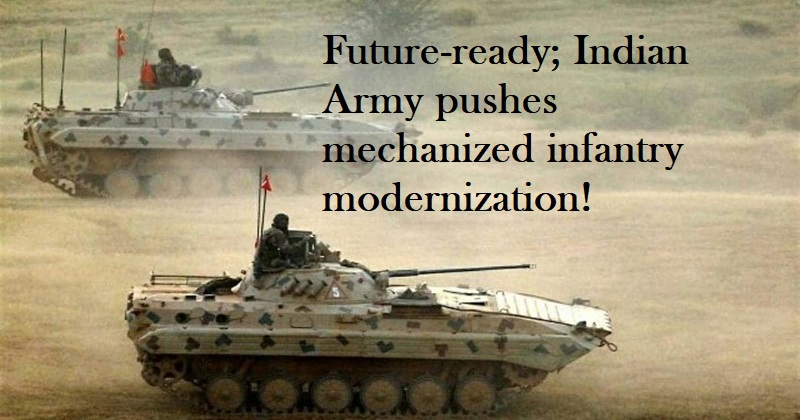
The Indian Army is preparing for future warfare by upgrading over 2,500 Russian Infantry Combat Vehicle BMP IIs as part of its effort to modernise its Mechanised Infantry battalions. The BMP II which has been in service since the 80s will remain the mainstay of the Mechanised Infantry Unit. The vehicle will now get equipped with night fighting capabilities, a high-power engine as well as anti-drone measures. This is in line with Atmanirbhar Bharat in Defence initiative, the Army has plans to acquire niche technology, also interoperability with other Arms.
Upgraded BMP II will have…
The BMP II will be equipped with specialized ammunition which explodes mid-air and can bring down drones and loitering munitions of a particular size. The night vision capability is now going to be augmented by Thermal Imager which is based on Driver Night Sight and Commander Thermal Imaging (TI) Sight for the Commander of BMP-2/2K.
Three Indian Companies in the race;
The biggest upgrade the existing BMP II would have is the ‘see-through armour’. This means the troops inside can get a full view of the situation outside day/night. Three companies under the iDEX (Innovation for Defence Excellence) initiative were identified/qualified — Big Bang Boom, Tonbo Imaging, and Dimensions NXG. There has been a delay in trials as one of the companies in race offered a system which was just a concept and another’s system was functionally flawed.
Upgraded BMPs will now be upgraded with magnetic trackers and cameras which will be integrated with helmet display. The helmet display integrated with the cameras will enable the commander to see images of the surroundings on the insides of the tanks. This is possible due to the magnetic tracker which senses the movement of the head and videos are displayed from the same direction.
Deployed in eastern Ladakh;
BMP2s were deployed along the confluence of the Galwan Valley and the Shyok River in eastern Ladakh to deter Chinese troops from entering the region. The armies of India and China continue to be locked in a standoff at several friction points along the Line of Actual Control (LAC).
Background;
The Indian Army’s Mechanised Infantry in the last four decades has proven its capability to be employed in both conventional and unconventional operations. It has excelled in different terrains and operations including high altitude areas of Eastern Ladakh & Sikkim, plains of Punjab and deserts of Rajasthan. And proved its mettle in amphibious operations and United Nations assignments.
The Indian Army has the BMP 2 which is being indigenously manufactured in India at the Ordnance Factory Board (OFB). There are plans to involve private sector companies in the manufacturing process. The BMP IIs have everything ‘Made in India,’ but, lack the night-vision capability. ‘When it is dark, there is smoke, or there is fog or dust, as it literally goes blind,’ explained a source quoted above.
The Indian Army is planning to replace BMP-IIs with around 480 locally developed FICVs and soon will seek the government’s approval for AoN (Acceptance of Necessity). In June 2021 for the third time the Indian Army had sent an RFI for the long delayed FICV. This will be done through upgrades for enhancing night enablement, Surveillance and Reconnaissance (ISR) capability, lethality, and intelligence.
There are plans to acquire the Canister Launched Loiter Munition System which will be integrated on BMP II/ Carrier Mortar Tracked (CMT) chassis. Anti-drone capability to be enabled on the existing equipment, and changes in aerial sight for the automatic 30 mm Cannon and co-axially mounted 7.62 mm Machine Gun (PKT). AoN has been accorded 105 New Wheeled Armoured Fighting Vehicle (WhAFV) for Standard Mechanised Infantry Battalions (Wheeled) RFI issued last month for Light Armoured Multi-Purpose Vehicle (LAMV) to replace the existing Maruti Gypsy. LAMV will have enhanced mobility and protection for Recce Platoon.

Post Your Comments